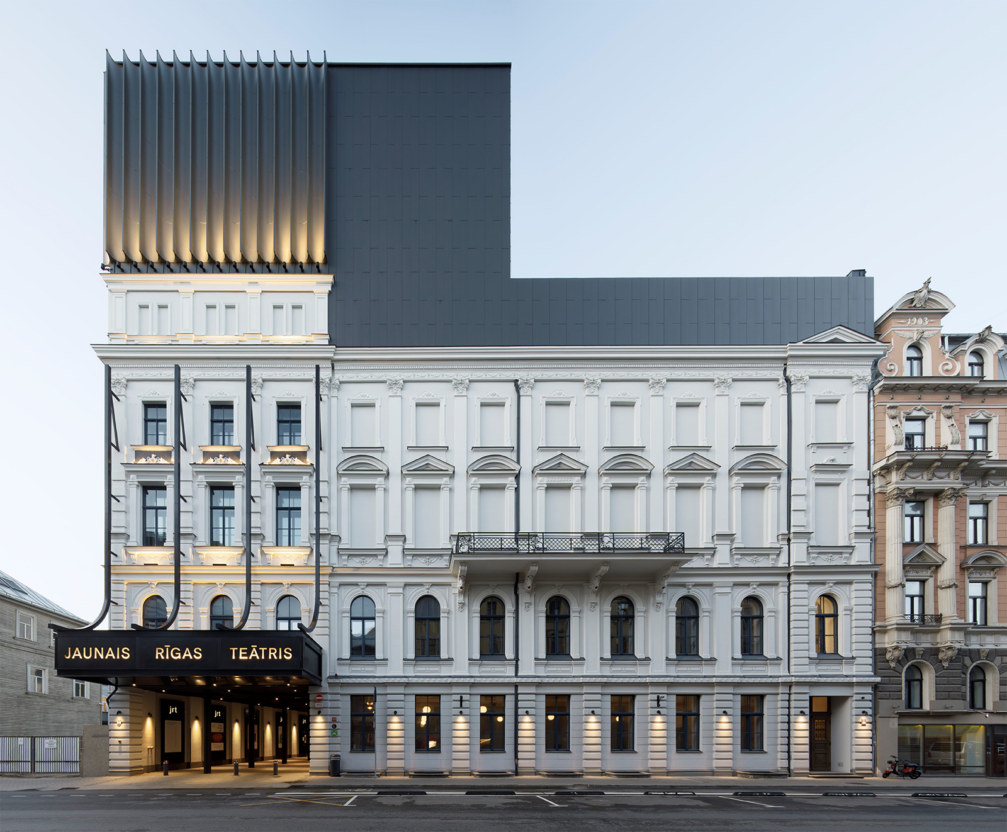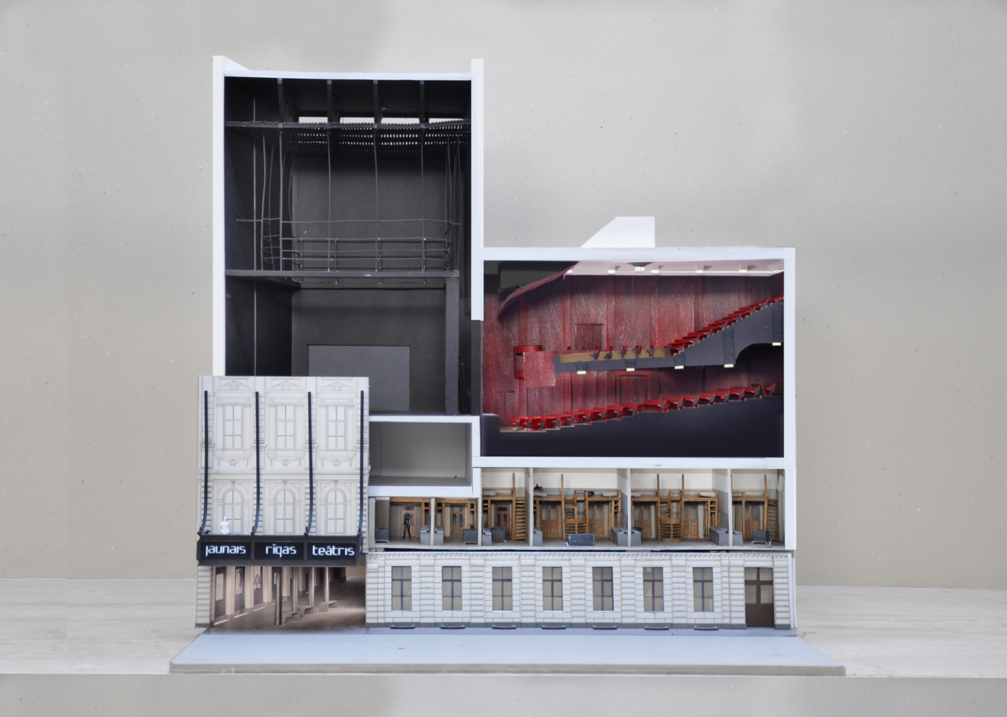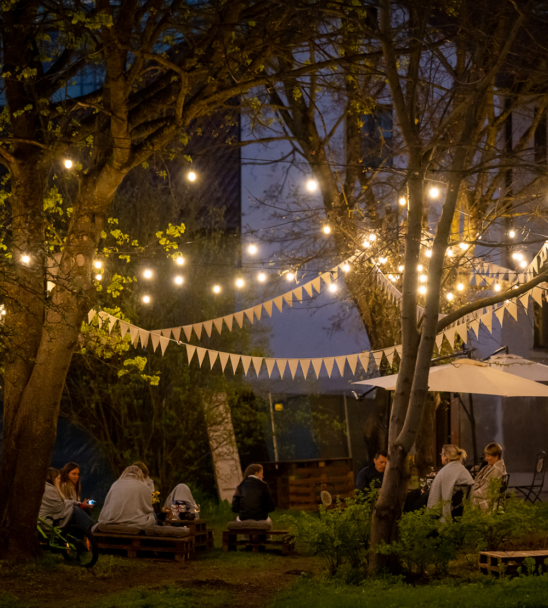
The New Riga Theatre, whose concept and project were created by the architecture office Zaigas Gailes Birojs but later also worked on by the studio Sarma and Norde, won the main prize at the Latvian Architecture Award 2024 in October. The project stands out both for its multi-layered architecture, which was especially emphasised by the international jury, and for its complex construction process, which was widely discussed by the local media.
Architecture
The New Riga Theatre building at Lāčplēša Street has undergone serious transformations — the volume of the historical building has almost doubled with the construction of underground spaces, while a new five-storey building with two Black Box halls and actors’ rooms has been added in the courtyard. The entrance to the theatre is located from the inner courtyard, creating an inviting outdoor space, while the cafe area facing Lāčplēša Street forms a connection between the inner spaces and the rest of the city. The former decoration rail has been translated into a glass corridor that connects the historical volume with the new technical building.



Although the solutions regarding the urban fabric — the main facade and the high technical attic tower, which now dominates the silhouette of Lāčplēša Street — have caused discussions, the interior is the strong point of the project. Zaigas Gailes birojs has managed to intertwine the new and the historical into a harmonious whole, preserving the most important historical elements: the familiar and nostalgic stairwells, whose former dilapidated state has been carefully embalmed, as well as the historical theatre hall. In it, the balcony has been completely rebuilt, changing its slope and ensuring better visibility; the stage has been significantly expanded, and modern technical stage solutions have been introduced. The original Art Deco aesthetics of the 1930s have been preserved in the hall, restoring the central chandelier and replacing other historical light fixtures and wall panelling with replicas.



The largest of the Black Box halls boasts the most modern equipment — it is completely transformable, and the placement of decorations and lights can be adjusted for any stage layout. Also, the theatre has acquired appropriate technical facilities as set design workshops.
The conceptual setting of the reconstruction is «theatre as a home», and this is most clearly manifested in the actors’ make-up rooms, whose interior has turned out to be really cosy, considering the long hours that the actors tend to spend there. One can feel that the architecture of the New Riga Theatre was created specifically for this theatre, the troupe, and its artistic director, expressing the values of the theatre and maintaining the connection with its history.
Process
In recent years, the Latvian Architecture Award has tried to emphasise the importance of architecture not only as a final result but also as a process, highlighting the importance of cooperation between the client, the builder, and the architect, as well as the impact of the building on the wider society and the architectural profession. This year’s jury also pointed out the importance of innovation and the architect’s role in the context of social responsibility as the main guiding principle that united all the nominated projects of the Latvian Architecture Award. However, the process of the theatre’s reconstruction has been plagued by various conflicts and ambiguities, causing broader discussions in society since the beginning of the reconstruction in 2013.
In the design sketch competition for the redevelopment of the theatre, the first prize was not awarded, the second prize went to the joint work of MADE Arhitekti and Gaiss Arhitekti, while the third prize was shared by Zaigas Gailes Birojs and Jaunromāns un Ābele Arhitekti. After the announcement of the competition results, without the first prize awarded, Zaiga Gaile lodged a complaint with the Procurement Monitoring Bureau, which was later withdrawn. However, no public information has been released about the negotiation procedure, which resulted in neither MADE Arhitekti and Gaiss Arhitekti nor Jaunromāns un Ābele Arhitekti being awarded the project, and we can only guess at the reasons for the choice. Zaiga Gaile emphasised at the time her hope that design proposals would not be judged solely on the lowest price, which was the purpose of organising a design competition. While public sector and European fund construction tenders most often go for the lowest price, the design competition is about the architectural quality of the project.
And yet, the ever-increasing cost of the theatre reconstruction has been one of the most discussed aspects of the project’s implementation in the public media. The final cost of the reconstruction, after several increases, reached 37 million, while the initial estimate offered by Zaigas Gailes Birojs was 19 million euros. Such an increase in costs cannot be explained only by the impact of the global pandemic and the increase in construction prices caused by the war in Ukraine. For comparison, the reconstruction of Rīgas cirks cost 5.5 million instead of the planned 4.5 million, while the cost of rebuilding the Tabakas Fabrika creative hub has increased from 3.8 to 4.9 million euros.
Construction deadlines have also been extended several times. The original plan was to open the building in 2020, but just two months after construction began, cracks began to appear in adjacent buildings during piling work, and construction work was halted. It was followed by more than half a year of delays, downtime, disputes between the client, builder, and architects, termination of the contract with the first builder, ReRe Būve, and a search for a new builder. After struggling with the slow financial flow, investing the builder’s own money in the project in order to keep the employees, and several postponements of the deadlines, the employees of the New Riga Theatre turned to the Prime Minister with an open letter of protest, asking to resolve the protracted reconstruction.
As the construction of the project moved forward and the outlines of the new building volume appeared over the facade of the historic Lāčplēša Street, discussions about the compliance of the reconstruction with the regulatory acts, especially the height restrictions of the buildings in the historical centre of Riga, became increasingly frequent among professionals. The National Cultural Heritage Administration has supported the project but has not provided an explanation as to why deviations from the regulations are permissible in this case and according to what criteria it was decided.
However, despite the complex and conflict-filled construction process, the reconstruction of the New Riga Theatre has finally been completed, tickets for performances in the new home of the troupe have been sold out months in advance, and the authors of the reconstruction won the laurels at both the Latvian Architecture Award and the Latvian Construction Award, whose juries seem to have judged the architecture in this case as an end product rather than an integrated process.












Viedokļi